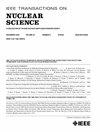高能 X 射线射线摄影的散射和模糊校正
IF 1.9
3区 工程技术
Q3 ENGINEERING, ELECTRICAL & ELECTRONIC
引用次数: 0
摘要
高能x射线照相作为一种穿透致密材料的高穿透成像方法是有用的。然而,这些能量的x射线相互作用的主要模式涉及散射或产生二次高能光子,这可能会干扰图像。此外,检测器模糊往往是由于检测器内部的散射造成的,会降低图像的清晰度。这两个过程都可以通过使用卷积核来缓解,主要的挑战是不知道正确使用的核,特别是对于分散贡献。通过对均匀衰减的固体板进行射线照相,我们发现可以确定点扩展函数和特定于材料的点散射函数,从而显著降低探测器模糊和物体散射的影响。限制对楼板的配合和楼板内的均匀传递足以恢复这些功能。提出了一种再现高能轫致辐射x射线角分布的函数形式,用于恢复点散射函数。将该方法应用于4 mv和7.5 mv端点能量的轫致辐射x射线源的物体x射线照片,观察到锐度显着增加。本文章由计算机程序翻译,如有差异,请以英文原文为准。
Scatter and Blur Corrections for High-Energy X-Ray Radiography
High-energy X-ray radiography is useful as a highly penetrating method for imaging through dense materials. However, the primary modes of interaction of X-rays at these energies involve scattering or the production of secondary high-energy photons, which can interfere with the image. In addition, detector blurring, often resulting from scatter within the detector, can reduce image sharpness. Both of these processes can be mitigated with the use of convolution kernels, with the main challenge being that the proper kernel to use is not known, particularly for the scatter contribution. By radiographing solid slabs of uniform attenuation, we show that point spread functions and material-specific point scatter functions can be determined to significantly reduce the effect of detector blurring and object scatter. Constraining the fits to the slabs and uniform transmission within the slabs is sufficient to recover these functions. A functional form that reproduces the angular distribution of high-energy bremsstrahlung X-rays is presented for recovering point scatter functions. The method is applied to radiographs of objects from bremsstrahlung X-ray sources operating at 4- and 7.5-MV endpoint energies and a significant increase in sharpness is observed.
求助全文
通过发布文献求助,成功后即可免费获取论文全文。
去求助
来源期刊

IEEE Transactions on Nuclear Science
工程技术-工程:电子与电气
CiteScore
3.70
自引率
27.80%
发文量
314
审稿时长
6.2 months
期刊介绍:
The IEEE Transactions on Nuclear Science is a publication of the IEEE Nuclear and Plasma Sciences Society. It is viewed as the primary source of technical information in many of the areas it covers. As judged by JCR impact factor, TNS consistently ranks in the top five journals in the category of Nuclear Science & Technology. It has one of the higher immediacy indices, indicating that the information it publishes is viewed as timely, and has a relatively long citation half-life, indicating that the published information also is viewed as valuable for a number of years.
The IEEE Transactions on Nuclear Science is published bimonthly. Its scope includes all aspects of the theory and application of nuclear science and engineering. It focuses on instrumentation for the detection and measurement of ionizing radiation; particle accelerators and their controls; nuclear medicine and its application; effects of radiation on materials, components, and systems; reactor instrumentation and controls; and measurement of radiation in space.
 求助内容:
求助内容: 应助结果提醒方式:
应助结果提醒方式:


